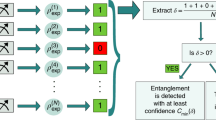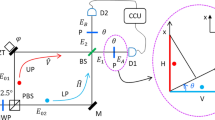Abstract
The violation of a Bell inequality is an experimental observation that forces the abandonment of a local realistic viewpoint—namely, one in which physical properties are (probabilistically) defined before and independently of measurement, and in which no physical influence can propagate faster than the speed of light1,2. All such experimental violations require additional assumptions depending on their specific construction, making them vulnerable to so-called loopholes. Here we use entangled photons to violate a Bell inequality while closing the fair-sampling loophole, that is, without assuming that the sample of measured photons accurately represents the entire ensemble3. To do this, we use the Eberhard form of Bell’s inequality, which is not vulnerable to the fair-sampling assumption and which allows a lower collection efficiency than other forms4. Technical improvements of the photon source5,6 and high-efficiency transition-edge sensors7 were crucial for achieving a sufficiently high collection efficiency. Our experiment makes the photon the first physical system for which each of the main loopholes has been closed, albeit in different experiments.
This is a preview of subscription content, access via your institution
Access options
Subscribe to this journal
Receive 51 print issues and online access
$199.00 per year
only $3.90 per issue
Buy this article
- Purchase on Springer Link
- Instant access to full article PDF
Prices may be subject to local taxes which are calculated during checkout



Similar content being viewed by others
References
Einstein, A., Podolsky, B. & Rosen, N. Can quantum-mechanical description of physical reality be considered complete? Phys. Rev. 47, 777–780 (1935)
Bell, J. S. On the Einstein Podolsky Rosen paradox. Physics 1, 195 (1964)
Pearle, P. M. Hidden-variable example based upon data rejection. Phys. Rev. D 2, 1418–1425 (1970)
Eberhard, P. H. Background level and counter efficiencies required for a loophole-free Einstein-Podolsky-Rosen experiment. Phys. Rev. A 47, 747–750 (1993)
Fedrizzi, A., Herbst, T., Poppe, A., Jennewein, T. & Zeilinger, A. A wavelength-tunable, fiber-coupled source of narrowband entangled photons. Opt. Express 15, 15377–15386 (2007)
Ramelow, S. et al. Highly efficient heralding of entangled single photons. Opt. Express 21, 6707–6717 (2013)
Lita, A. E., Miller, A. J. & Nam, S. W. Counting near-infrared single-photons with 95% efficiency. Opt. Express 16, 3032–3040 (2008)
Garg, A. & Mermin, N. D. Detector inefficiencies in the Einstein-Podolsky-Rosen experiment. Phys. Rev. D 35, 3831–3835 (1987)
Rowe, M. A. et al. Experimental violation of a Bell’s inequality with efficient detection. Nature 409, 791–794 (2001)
Ansmann, M. et al. Violation of Bell’s inequality in Josephson phase qubits. Nature 461, 504–506 (2009)
Alicki, R. Remarks on the violation of Bell’s inequality in Josephson phase qubits. Preprint at http://arxiv.org/abs/0911.4009 (2009)
Matsukevich, D. N., Maunz, P., Moehring, D. L., Olmschenk, S. & Monroe, C. Bell inequality violation with two remote atomic qubits. Phys. Rev. Lett. 100, 150404 (2008)
Hofmann, J. et al. Heralded entanglement between widely separated atoms. Science 337, 72–75 (2012)
Freedman, S. J. & Clauser, J. F. Experimental test of local hidden-variable theories. Phys. Rev. Lett. 28, 938–941 (1972)
Kwiat, P. G. & Eberhard, P. H. Steinberg, A. M. & Chiao, R. Y. Proposal for a loophole-free Bell inequality experiment. Phys. Rev. A 49, 3209–3220 (1994)
Rosenfeld, W. et al. Towards a loophole-free test of Bell’s inequality with entangled pairs of neutral atoms. Adv. Sci. Lett. 2, 469–474 (2009)
Aspect, A., Dalibard, J. & Roger, G. Experimental test of Bell’s inequalities using time-varying analyzers. Phys. Rev. Lett. 49, 1804–1807 (1982)
Weihs, G., Jennewein, T., Simon, C., Weinfurter, H. & Zeilinger, A. Violation of Bell’s inequality under strict Einstein locality conditions. Phys. Rev. Lett. 81, 5039–5043 (1998)
Scheidl, T. et al. Violation of local realism with freedom of choice. Proc. Natl Acad. Sci. USA 107, 19708–19713 (2010)
Merali, Z. Quantum mechanics braces for the ultimate test. Science 331, 1380–1382 (2011)
Smith, D. H. et al. Conclusive quantum steering with superconducting transition-edge sensors. Nature Commun. 3, 625–631 (2012)
Bennet, A. J. et al. Arbitrarily loss-tolerant Einstein-Podolsky-Rosen steering allowing a demonstration over 1 km of optical fiber with no detection loophole. Phys. Rev. X 2 (3), 031003 (2012)
Wittmann, B. et al. Loophole-free Einstein–Podolsky–Rosen experiment via quantum steering. N. J. Phys. 14, 053030 (2012)
Clauser, J. F. & Horne, M. A. Experimental consequences of objective local theories. Phys. Rev. D 10, 526–535 (1974)
Brunner, N., Gisin, N., Scarani, V. & Simon, C. Detection loophole in asymmetric Bell experiments. Phys. Rev. Lett. 98, 220403 (2007)
Vértesi, T., Pironio, S. & Brunner, N. Closing the detection loophole in Bell experiments using qudits. Phys. Rev. Lett. 104, 060401 (2010)
Clauser, J. F., Horne, M. A., Shimony, A. & Holt, R. A. Proposed experiment to test local hidden-variable theories. Phys. Rev. Lett. 23, 880–884 (1969)
Kim, T., Fiorentino, M. & Wong, F. N. C. Phase-stable source of polarization-entangled photons using a polarization Sagnac interferometer. Phys. Rev. A 73, 012316 (2006)
Drung, D. et al. Highly sensitive and easy-to-use SQUID sensors. IEEE Trans. Appl. Supercond. 17, 699–704 (2007)
Acknowledgements
We acknowledge M. Schmidt of Physikalisch-Technische Bundesanstalt in Berlin, Germany, for assistance with setting up the TES-SQUID system. This work was supported by the ERC (Advanced Grant number QIT4QAD 227844), the Austrian Science Fund (FWF) under projects SFB F4008 and CoQuS, the grant Q-ESSENCE (number 248095), QAP (number 15848), the Marie Curie Research Training Network EMALI (number MRTN-CT-2006-035369) and the John Templeton Foundation. This work was also supported by the NIST Quantum Information Science Initiative (QISI), an agency of the US Government.
Author information
Authors and Affiliations
Contributions
M.G. designed and carried out the experiment, and analysed data. A.M. designed and carried out the experiment. S.R. provided theoretical analysis, designed and carried out the experiment, and analysed data. B.W. designed and carried out the experiment. J.K. provided theoretical analysis, and analysed data. J.B., A.L., B.C., T.G. and S.W.N. provided experimental and conceptual assistance. R.U. designed the experiment and provided experimental, organizational and conceptual assistance. A.Z. conceived the research and guided the experiment. All authors wrote the manuscript.
Corresponding authors
Ethics declarations
Competing interests
The authors declare no competing financial interests.
Rights and permissions
About this article
Cite this article
Giustina, M., Mech, A., Ramelow, S. et al. Bell violation using entangled photons without the fair-sampling assumption. Nature 497, 227–230 (2013). https://doi.org/10.1038/nature12012
Received:
Accepted:
Published:
Issue Date:
DOI: https://doi.org/10.1038/nature12012
This article is cited by
-
Quantum Entanglement Partly Demystified
International Journal of Theoretical Physics (2024)
-
Applications of single photons in quantum metrology, biology and the foundations of quantum physics
Nature Reviews Physics (2023)
-
Advances in device-independent quantum key distribution
npj Quantum Information (2023)
-
Superconducting detectors count more photons
Nature Photonics (2023)
-
A comprehensive review of quantum random number generators: concepts, classification and the origin of randomness
Quantum Information Processing (2023)
Comments
By submitting a comment you agree to abide by our Terms and Community Guidelines. If you find something abusive or that does not comply with our terms or guidelines please flag it as inappropriate.



